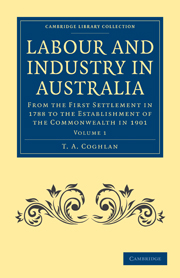 Labour and Industry in Australia
Labour and Industry in Australia Book contents
- Frontmatter
- PREFACE
- Contents
- PART I FROM THE FOUNDATION OF SETTLEMENT TO THE CROSSING OF THE MOUNTAINS
- I INTRODUCTION TO THE FIRST PERIOD
- II THE ASSIGNMENT SYSTEM
- III MUSTERS
- IV WAGES AND WORKING HOURS
- V THE CURRENCY
- VI LAND POLICY
- VII THE GENESIS OF THE WOOL INDUSTRY IN AUSTRALIA
- VIII THE INDUSTRIES OF THE PERIOD
- IX TRADE AND PRICES
- PART II FROM THE CROSSING OF THE MOUNTAINS TO THE ABOLITION OF THE ASSIGNMENT SYSTEM
- PART III FROM THE ABOLITION OF THE ASSIGNMENT SYSTEM TO THE DISCOVERY OF GOLD
- PART IV FROM THE DISCOVERY OF GOLD TO THE INTRODUCTION OF FREE SELECTION OF LAND BEFORE SURVEY
VII - THE GENESIS OF THE WOOL INDUSTRY IN AUSTRALIA
Published online by Cambridge University Press: 05 August 2011
- Frontmatter
- PREFACE
- Contents
- PART I FROM THE FOUNDATION OF SETTLEMENT TO THE CROSSING OF THE MOUNTAINS
- I INTRODUCTION TO THE FIRST PERIOD
- II THE ASSIGNMENT SYSTEM
- III MUSTERS
- IV WAGES AND WORKING HOURS
- V THE CURRENCY
- VI LAND POLICY
- VII THE GENESIS OF THE WOOL INDUSTRY IN AUSTRALIA
- VIII THE INDUSTRIES OF THE PERIOD
- IX TRADE AND PRICES
- PART II FROM THE CROSSING OF THE MOUNTAINS TO THE ABOLITION OF THE ASSIGNMENT SYSTEM
- PART III FROM THE ABOLITION OF THE ASSIGNMENT SYSTEM TO THE DISCOVERY OF GOLD
- PART IV FROM THE DISCOVERY OF GOLD TO THE INTRODUCTION OF FREE SELECTION OF LAND BEFORE SURVEY
Summary
During the first few years of settlement nothing could have seemed less likely than that the production of wool would ever become the most important industry of Australia. It seemed rather that the climate and other natural conditions of the country were fatal to the miserable sheep, which found themselves driven ashore to wander on the scrubby hills about the anxious little settlement. Forty-four sheep were landed from the First Fleet in 1788. Sickness attacked them immediately, and they were greatly worried by the dingoes, so that at the end of three months fifteen were dead, and the mischief continued until only one was left. However, greater care was taken of later importations, and it was found that sheep might be bred with some success, even in the moist coastal regions about Sydney, though many died of foot-rot and water in the head.
In the year 1791 there came to Sydney with the New South Wales Corps one Captain John Macarthur, a freshcomplexioned, handsome soldier with blue eyes and auburn hair. The son of a Plymouth tradesman, he had married the daughter of a gentleman farmer, and had himself engaged in farming in England. At one time he had held a commission in the Militia, but had resolved to transfer himself to New South Wales as an officer in the newly formed Corps. He was a man of great business ability, with a remarkable aptitude for farming, and in this pursuit he was admirably seconded by his wife.
- Type
- Chapter
- Information
- Labour and Industry in AustraliaFrom the First Settlement in 1788 to the Establishment of the Commonwealth in 1901, pp. 93 - 113Publisher: Cambridge University PressPrint publication year: 2011First published in: 1918


